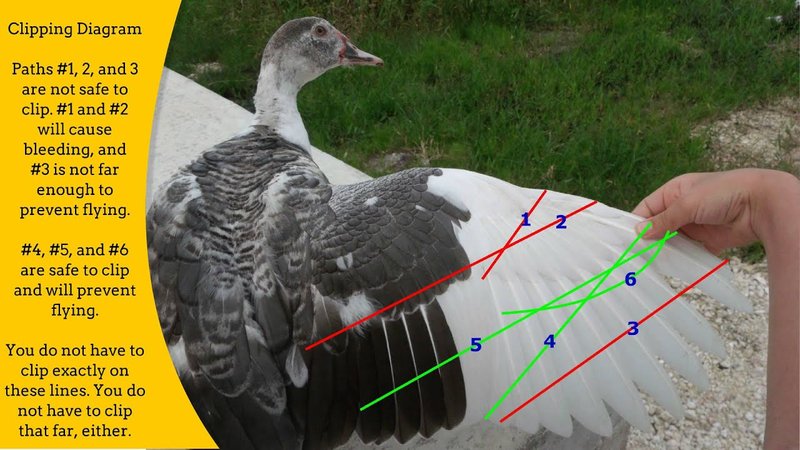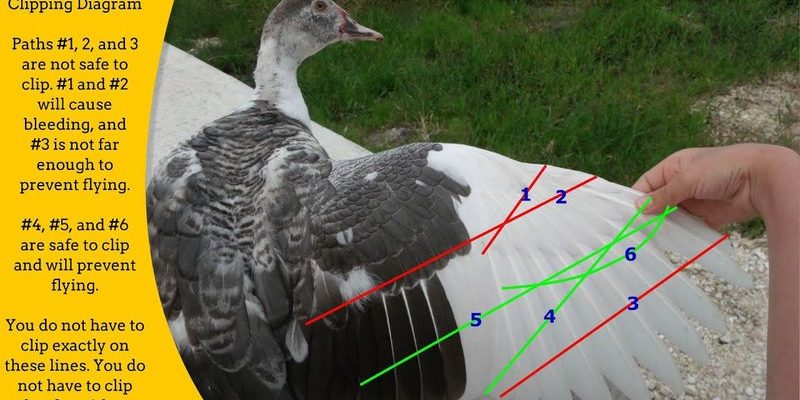
In this guide, we’ll walk through the how-to’s of clipping a duck’s wings safely and effectively. Think of this as your friendly chat over coffee, where I break down everything you need to know, from the best tools to use to the step-by-step process. Clipping a duck’s wings isn’t just a practical task; it’s also an important aspect of responsible pet ownership. So, let’s dive in!
Why Clipping a Duck’s Wings is Important
Understanding the purpose behind wing clipping is crucial before you begin. Clipping a duck’s wings can help limit their ability to fly away, which is especially important if you’re keeping them in a backyard environment. Remember, ducks are naturally curious creatures and may wander off if given the chance.
* Safety Concerns: Without wing clipping, ducks can easily escape and find themselves in dangerous situations, like busy streets or predators. Clipping helps keep them within a safe area.
* Preventing Injury: Ducks can hurt themselves when they fly into objects or if they get caught in fences. By limiting their flight, you reduce the risk of these accidents.
* Control: If you have a flock, clipped wings can make it easier to manage their movements and ensure they stay together.
By understanding these points, you can approach the task of clipping with a sense of responsibility and care.
What You Need for Clipping
Before you start, gather your tools to make the process smooth and safe. Having everything ready makes a world of difference.
* Sharp Scissors or Wing Clippers: Invest in a good pair of scissors or clippers specifically designed for this purpose. They should be sharp enough to cut through feathers but not so sharp that they can accidentally hurt your duck.
* Towel: A towel can help wrap your duck gently, keeping them calm and preventing them from flapping around too much.
* Treats: Ducks love treats! Having some on hand can make the experience positive for them. A few peas or mealworms can go a long way.
With these tools on hand, you’ll be well-prepped for a successful wing clipping.
Understanding Duck Anatomy
It helps to have a basic grasp of duck anatomy to understand where to clip. Ducks have a specific part of their wing called the primary feathers, which give them the lift needed for flying.
* Primary Feathers: These are the long feathers that extend from the wrist of the wing. Only clip the outermost ones; this will disrupt their flying without causing them any pain.
* Secondary Feathers: These feathers are shorter and closer to the body. Avoid cutting these, as they don’t help with flight control like the primaries do.
By knowing these basics, you can approach the clipping process with confidence, ensuring you only do what’s necessary.
How to Clip a Duck’s Wings Safely
Now it’s time for the main event! Clipping wings might seem daunting, but if you take your time and follow these steps, you’ll be just fine.
1. Prepare the Area: Choose a calm, quiet spot where you can focus on your duck without distractions. Ensure you have all your tools ready.
2. Wrap Your Duck: Use a towel to gently wrap your duck, leaving one wing out. This will help keep them calm and reduce movement. Make sure not to wrap too tightly—just enough to hold them securely.
3. Identify the Feathers to Cut: Look at the outermost primary feathers on the wing. You want to identify those that are about halfway down the wing.
4. Make the Cuts: Carefully cut the primary feathers, ensuring you’re only trimming. Aim to remove about 1-2 inches from the tips, just enough to prevent flying. Be gentle and take your time!
5. Reward Your Duck: After you finish one wing, give them a treat! This makes them associate the experience with something positive. Once you’ve completed both wings, reward them again.
Remember, if you feel unsure, it’s okay to consult with a veterinarian or an experienced duck owner for guidance.
Common Mistakes to Avoid
When clipping a duck’s wings, it’s easy to make a few common mistakes, especially if you’re new to this. Here are some to steer clear of:
* Cutting Too Much: One of the biggest mistakes is cutting too many feathers or cutting them too short. Stick with trimming just the tips to minimize the risk of injuries.
* Rushing the Process: Take your time. Ducks can be skittish, and rushing can lead to stress for both you and your duck.
* Ignoring Safety: Always make sure your duck is calm and that your tools are safe for use. A scared or struggling duck can get hurt.
By avoiding these pitfalls, you’ll make the experience better for both you and your duck.
Aftercare and Monitoring
After you’ve clipped your duck’s wings, it’s important to keep an eye on them for a few days. This will help ensure they adjust well to their clipped state.
* Watch Their Behavior: Observe how your duck behaves. They might be a bit confused at first but should adapt quickly. If they seem overly stressed, it might help to give them a little extra space.
* Keep Their Environment Safe: Make sure their living area is secure to prevent any potential escape attempts and keep them safe from predators.
* Monitor Feather Growth: Over time, clipped feathers will grow back. Be prepared to repeat the process a few times a year to maintain control.
Regular monitoring will help ensure that your duck remains healthy, happy, and secure in their environment.
Alternatives to Wing Clipping
While clipping is a common method to keep ducks grounded, there are alternatives you might consider if you’re not comfortable with it.
* Fencing: Building a safe enclosure can prevent ducks from flying away while they still retain their ability to fly. Just make sure it’s tall enough to keep them in.
* Training: With some patience, ducks can learn to stay within boundaries through positive reinforcement training. Using treats can encourage them to stay in a designated area.
* Leashing: Some duck owners use harnesses for walks. This allows ducks a bit of freedom while still being safely tethered.
These options can be more labor-intensive but may suit some duck owners better than clipping.
Clipping a duck’s wings safely is a helpful skill for any duck owner. It helps keep your feathered friends safe and sound while also allowing you to enjoy their company without the worry of them flying off. With the right tools, knowledge of anatomy, and a calm approach, you can master this task.
Remember to be patient, avoid common mistakes, and always reward your duck. And if you ever feel uncertain, don’t hesitate to ask for help. After all, it’s about ensuring your ducks stay happy and healthy in their little world!

